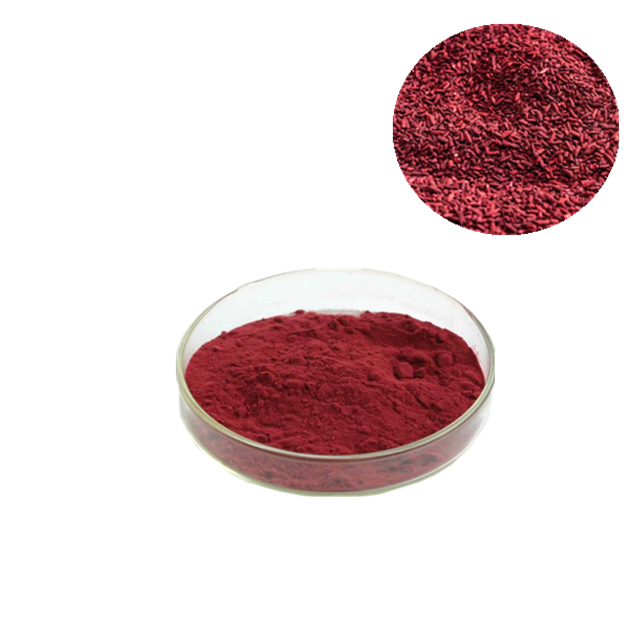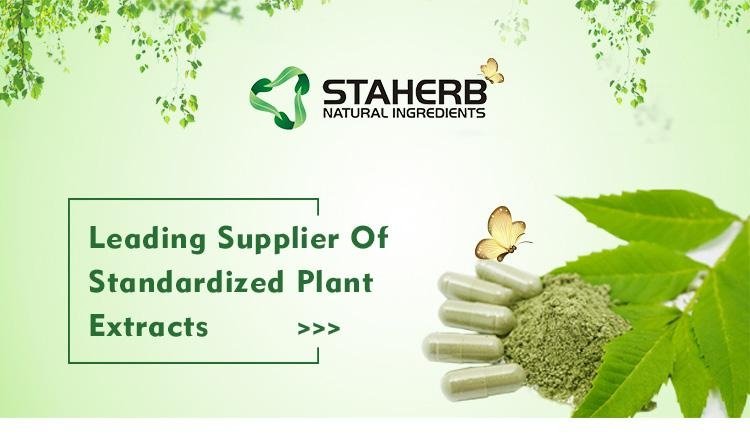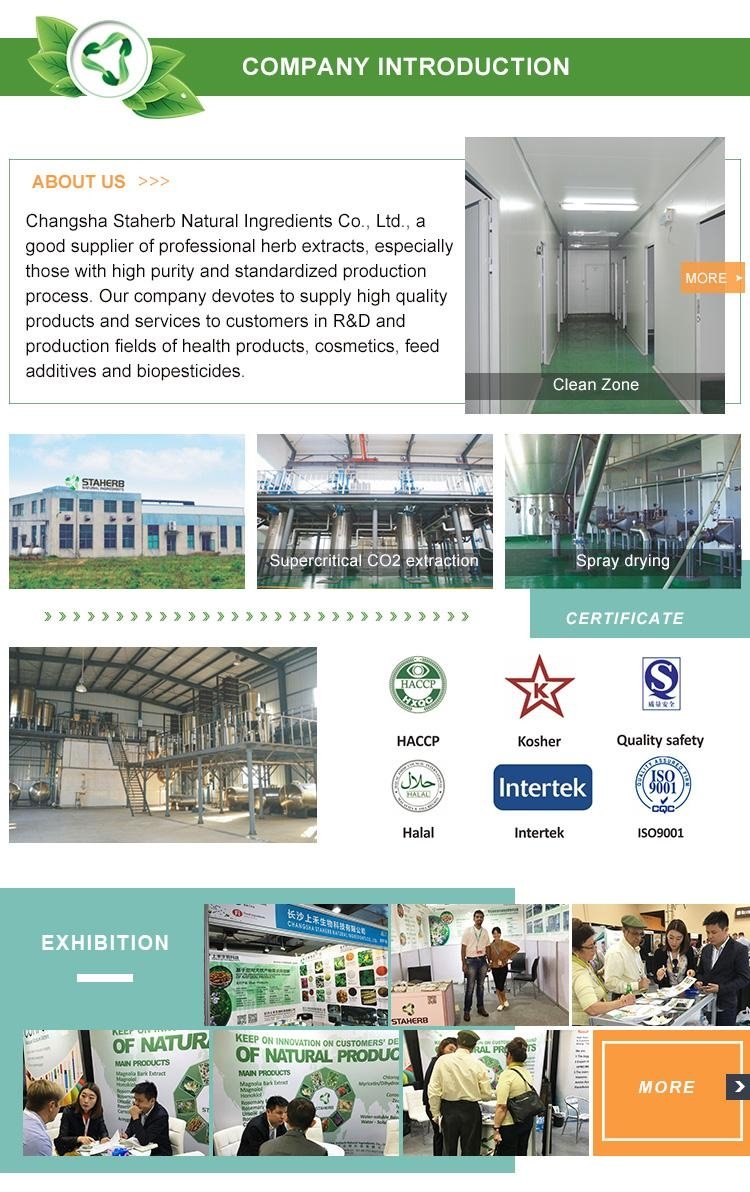Red yeast extract monacolin
Latin name: monascus purpureus
Plant Origin: seed
Active ingredient: Lovastatin (Monacolin K)
Content: Monacolin K0.1%-3%, Lovastatin0.1%-3%
Specification: 5:1,10:1,20:1
Test Method: TLC
CAS No.:75330-75-5
Appearance: Red fine powder
What is Red Yeast Rice Powder
Rich in biological activity of enzymes and a variety of physiological active substances, Monacolin-K, ergosterol, γ-aminobutyric acid, natural plant hormones, such as Monascus metabolites with a high nutrition, health, medicinal value, without any side effects, is a natural, safe and effective health food products, pharmaceuticals raw materials. Product Quality safe and reliable.
Red Yeast Rice (Monascus purpureus) can also be called red kojic rice, red koji rice or red fermented rice. It is colored red to reddish purple rice which is due to being grown and cultivated with a mold that is called Monascus purpureus. Red Yeast Rice Powder from this type of rice has been used as a food coloring agent; it has been widely used in China to color tofu, red rice vinegar, cooking Peking duck and in making several varieties of Chinese pastries. Red Yeast Rice Powder has been commercially used as an ingredient in medications that lower the body’s natural cholesterol levels. The debate on whether Red Yeast Rice Powder is a drug or a food supplement is still being studied by the Food and Drug Administration in the United States.
It is used as a food flavoring agent and as a traditional medicine to promote circulation and heart health.
Function
1. Promote blood circulation, soothe upset stomach, and invigorate the function of the spleen;
2. This dietary supplement has been used traditionally for bruised muscles, hangovers, indigestion, and colic in infants;
3. Red yeast rice contains substances that are similar to prescription medications that lower cholesterol;
4. There is also growing interest in evaluating red yeast rice for use as a natural food dye and preservative.
Application:
1) As raw materials of drugs for lowering blood pressure and Alzheimer's disease, it is mainly used in pharmaceutical field;
2) As active ingredient of products for improving blood circulation and benefiting stomach, it is mainly used in health product industry;
3) As food supplements and natural pigment, it is widely used in food industry.
For more product information pls contact email sales09@staherb.cn
Physical Index
|
Item
|
Specification
|
Results
|
|
Appearance
|
Light-red fine powder
|
Complies
|
|
Odor
|
Characteristic
|
Complies
|
|
Assay (By HPLC) Monacolin-k
|
>2.0%
|
2.11%
|
|
Sieve Analysis
|
100% pass 80 mesh
|
Complies
|
|
Loss on Drying
|
<8.0%
|
3.41%
|
|
Residue on Ignition
|
<5.0%
|
2.37%
|
|
Bulk Density
|
45-55g/100mL
|
51.5g/100mL
|
|
Heavy Metal
|
<10ppm
|
Complies
|
|
As
|
<2ppm
|
Complies
|
|
Residual Solvents
|
Eur.Pharm.
|
Complies
|
|
Microbiology
|
|
|
|
Total Plate Count
|
<1000/g
|
148/g
|
|
Yeast & Mold
|
<100/g
|
42/g
|
|
E.Coli
|
Negative
|
Complies
|
|
Salmonella
|
Negative
|
Complies
|
References:
- 1.
Go AS, Mozaffarian D, Roger VL, Benjamin EJ, Berry JD, Blaha MJ, et al. Executive summary: heart disease and stroke statistics–2014 update: a report from the American Heart Association. Circulation. 2014;129:399–410.
- 2.
Ervin RB. Prevalence of metabolic syndrome among adults 20 years of age and over, by sex, age, race and ethnicity, and body mass index: United States, 2003–2006. Natl Health Stat Rep. 2009:1–7.
- 3.
Misra A, Khurana L. Obesity and the metabolic syndrome in developing countries. J Clin Endocrinol Metab. 2008;93:S9–30.
- 4.
Dunstan DW, Zimmet PZ, Welborn TA, De Courten MP, Cameron AJ, Sicree RA, et al. The rising prevalence of diabetes and impaired glucose tolerance. The Australian Diabetes, Obesity and Lifestyle Study. Diabetes Care. 2002;25:829–34.
- 5.
Van Gaal LF, Mertens IL, De Block CE. Mechanisms linking obesity with cardiovascular disease. Nature. 2006;444:875–80.
- 6.
Gaede P, Vedel P, Larsen N, Jensen GV, Parving HH, Pedersen O. Multifactorial intervention and cardiovascular disease in patients with type 2 diabetes. N Engl J Med. 2003;348:383–93.
- 7.
Expert Dyslipidemia Panel of the International Atherosclerosis Society Panel members. An International Atherosclerosis Society Position Paper: global recommendations for the management of dyslipidemia–full report. J Clin Lipidol. 2014;8:29–60.
- 8.
EFSA. Scientific Opinion on the substantiation of health claims related to monacolin K from red yeast rice and maintenance of normal blood LDL cholesterol concentrations (ID 1648, 1700) pursuant to Article 13(1) of Regulation (EC) No 1924/2006. EFSA J. 2011;9:2304.
- 9.
Roberts CK, Sindhu KK. Oxidative stress and metabolic syndrome. Life Sci. 2009;84:705–12.
- 10.
EFSA. Scientific Opinion on the substantiation of health claims related to polyphenols in olive and protection of LDL particles from oxidative damage (ID 1333, 1638, 1639, 1696, 2865), maintenance of normal blood HDL-cholesterol concentrations (ID 1639), maintenance of normal blood pressure (ID 3781), “anti-inflammatory properties” (ID 1882), “contributes to the upper respiratory tract health” (ID 3468), “can help to maintain a normal function of gastrointestinal tract” (3779), and “contributes to body defences against external agents” (ID 3467) pursuant to Article 13(1) of Regulation (EC) No 1924/20061. EFSA J. 2011;9:2033
- 11.
Grundy SM, Brewer Jr HB, Cleeman JI, Smith Jr SC, Lenfant C, American Heart Association, et al. Definition of metabolic syndrome: Report of the National Heart, Lung, and Blood Institute/American Heart Association conference on scientific issues related to definition. Circulation. 2004;109:433–8.
- 12.
Rifai N, Warnick GR, McNamara JR, Belcher JD, Grinstead GF, Frantz Jr ID. Measurement of low-density-lipoprotein cholesterol in serum: a status report. Clin Chem. 1992;38:150–60.
- 13.
Conroy RM, Pyörälä K, Fitzgerald AP, Sans S, Menotti A, De Backer G, et al. Estimation of ten-year risk of fatal cardiovascular disease in Europe: the SCORE project. Eur Heart J. 2003;24:987–1003.
- 14.
Law MR, Wald NJ, Rudnicka AR. Quantifying effect of statins on low density lipoprotein cholesterol, ischaemic heart disease, and stroke: systematic review and meta-analysis. BMJ. 2003;326:1407–8.
- 15.
Yong-Guo LI, Hong L, Zheng-Tao Wang A. validated stability-indicating HPLC with photodiode array detector (PDA) method for the stress tests of Monascus purpureus-fermented rice, red yeast rice. J Pharm Biomed Anal. 2005;39:82–90.
- 16.
Navarra T, Del Turco S, Berti S, Basta G. The lectin-like oxidized low-density lipoprotein receptor-1 and its soluble form: cardiovascular implications. J Atheroscler Thromb. 2010;17:317–31.
- 17.
Tsimikas S, Miller YI. Oxidative modification of lipoproteins: mechanisms, role in inflammation and potential clinical applications in cardiovascular disease. Curr Pharm Des. 2011;17:27–37.
- 18.
EFSA Panel on Dietetic Products, Nutrition and Allergies. Guidance on the scientific requirements for health claims related to antioxidants, oxidative damage and cardiovascular health. EFSA J. 2011;9:2474.
- 19.
Nauck M, Warnick GR, Rifai N. Methods for measurement of LDL-cholesterol: a critical assessment of direct measurement by homogeneous assays versus calculation. Clin Chem. 2002;48:236–54.
- 20.
Mancini GB, Baker S, Bergeron J, Fitchett D, Frohlich J, Genest J, et al. Diagnosis, prevention, and management of statin adverse effects and intolerance: proceedings of a Canadian Working Group Consensus Conference. Can J Cardiol. 2011;27:635–62.
- 21.
Bogsrud MP, Ose L, Langslet G, Ottestad I, Strøm EC, Hagve TA, et al. HypoCol (red yeast rice) lowers plasma cholesterol - a randomized placebo controlled study. Scand Cardiovasc J. 2010;44:197–200. doi:10.3109/14017431003624123.
- 22.
Verhoeven V, Lopez Hartmann M, Remmen R, Wens J, Apers S, Van Royen P. Red yeast rice lowers cholesterol in physicians - a double blind, placebo controlled randomized trial. BMC Complement Altern Med. 2013;13:178.
- 23.
Chen CH, Yang JC, Uang YS, Lin CJ. Improved dissolution rate and oral bioavailability of lovastatin in red yeast rice products. Int J Pharm. 2013;444:18–24
- 24.
Venero CV, Venero JV, Wortham DC, Thompson PD. Lipid-lowering efficacy of red yeast rice in a population intolerant to statins. Am J Cardiol. 2010;105:664–6.
- 25.
Furukawa S, Fujita T, Shimabukuro M, Iwaki M, Yamada Y, Nakajima Y, et al. Increased oxidative stress in obesity and its impact on metabolic syndrome. J Clin Invest. 2004;114:1752–61.
- 26.
Keaney Jr JF, Larson MG, Vasan RS, Wilson PW, Lipinska I, Corey D, et al. Obesity and systemic oxidative stress: clinical correlates of oxidative stress in the Framingham Study. Arterioscler Thromb Vasc Biol. 2003;23:434–9.
- 27.
Grattagliano I, Palmieri VO, Portincasa P, Moschetta A, Palasciano G. Oxidative stress-induced risk factors associated with the metabolic syndrome: a unifying hypothesis. J Nutr Biochem. 2008;19:491–504.
- 28.
Van Guilder GP, Hoetzer GL, Greiner JJ, Stauffer BL, Desouza CA. Influence of metabolic syndrome on biomarkers of oxidative stress and inflammation in obese adults. Obesity (Silver Spring). 2006;14:2127–31.
- 29.
Holvoet P, Lee DH, Steffes M, Gross M, Jacobs Jr DR. Association between circulating oxidized low-density lipoprotein and incidence of the metabolic syndrome. JAMA. 2008;299:2287–93.
- 30.
Wierzbicki AS, Clarke RE, Viljoen A, Mikhailidis DP. Triglycerides: a case for treatment? Curr Opin Cardiol. 2012;27:398–404.
- 31.
Ballantyne CM, Raichlen JS, Cain VA. Statin therapy alters the relationship between apolipoprotein B and low-density lipoprotein cholesterol and non-high-density lipoprotein cholesterol targets in high-risk patients: the MERCURY II (Measuring Effective Reductions in Cholesterol Using Rosuvastatin) trial. J Am Coll Cardiol. 2008;52:626–32.
- 32.
Psaltopoulou T, Naska A, Orfanos P, Trichopoulos D, Mountokalakis T, Trichopoulou A. Olive oil, the Mediterranean diet, and arterial blood pressure: the Greek European Prospective Investigation into Cancer and Nutrition (EPIC) study. Am J Clin Nutr. 2004;80:1012–8.
- 33.
Gilani AH, Khan AU, Shah AJ, Connor J, Jabeen Q. Blood pressure lowering effect of olive is mediated through calcium channel blockade. Int J Food Sci Nutr. 2005;56:613–20.
- 34.
Doménech M, Roman P, Lapetra J, de la Corte FJ G, Sala-Vila A, de la Torre R. Mediterranean diet reduces 24-hour ambulatory blood pressure, blood glucose, and lipids: one-year randomized, clinical trial. Hypertension. 2014;64:69–76.
- 35.
Toledo E, Hu FB, Estruch R, Buil-Cosiales P, Corella D, Salas-Salvadó J, et al. Effect of the Mediterranean diet on blood pressure in the PREDIMED trial: results from a randomized controlled trial. BMC Med. 2013;11:207. doi:10.1186/1741-7015-11-207.
- 36.
Preiss D, Seshasai SR, Welsh P, Murphy SA, Ho JE, Waters DD. Risk of incident diabetes with intensive-dose compared with moderate-dose statin therapy: a meta-analysis. JAMA. 2011;305:2556–64.
- 37.
Matikainen N, Taskinen MR. Management of dyslipidemias in the presence of the metabolic syndrome or type 2 diabetes. Curr Cardiol Rep. 2012;14:721–31.
- 38.
Yinhua L, Long J, Zhangrong J, Wei X, Shiwei Y, Qiu Y, et al. A meta-analysis of red yeast rice: an effective and relatively safe alternative approach for Dyslipidemia. PLoS One. 2014;9:e98611.
- 39.
Becker DJ, Gordon RY, Halbert SC, French B, Morris PB, Rader DJ. Red yeast rice for dyslipidemia in statin-intolerant patients: a randomized trial. Ann Intern Med. 2009;150:830–9.
- 40.
Lapi F, Gallo E, Bernasconi S, Vietri M, Menniti-Ippolito F, Raschetti R, et al. Myopathies associated with red yeast rice and liquorice: spontaneous reports from the Italian Surveillance System of Natural Health Products. Br J Clin Pharmacol. 2008;66:572–4.
- 41.
Mueller PS. Symptomatic myopathy due to red yeast rice. Ann Intern Med. 2006;145:474–5.
- 42.
Gordon RY, Cooperman T, Obermeyer W, Becker DJ. Marked variability of monacolin levels in commercial red yeast rice products: buyer beware! Arch Intern Med. 2010;170:1722–7.
- 43.
Li YG, Zhang F, Wang ZT, Hu ZB. Identification and chemical profiling of monacolins in red yeast rice using high-performance liquid chromatography with photodiode array detector and mass spectrometry. J Pharm Biomed Anal. 2004;35:1101–12.
- 44.
Hsin-Ping O, Wang C-CR, Lih-Shiuh L. Thermal degradation kinetics analysis of monacolin K in Monascus-fermentated products LWT. Food Sci Technol. 2009;42:292–6.
-
Changsha Staherb Natural Ingredients Co.,ltd.
Address: Room.202, Buliding B8, Huanchuang Enterprise Square, High-tech Development Zone, Changsha, Hunan, China(410205)
Contact:Mary
Email: sales05@staherb.cn sales@staherb.cn
Tel :+86-(0)731-84213302 Fax:+86-(0)731-85953715
Website:www.staherb.cn
|
|




